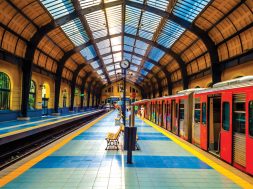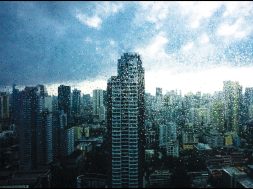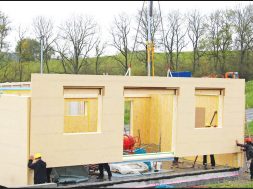Avani Riverside:India’s first platinum rated mall unveils
Avani Riverside mall, the crowning glory of Hooghly riverbank, is a standard of sustainable development not only in Kolkata but in India
Malls are symbols of urbanisation and prosperity in big cities. Today malls are more than a place to shop; they are now the centre of social activities and big businesses. Be it entertainment, food or fitness, malls have become an integral part of modern lifestyle. At the same time, malls can contribute hugely in greenhouse gas emission consuming energy inefficiently and using natural resources indiscriminately.
As the concept of green buildings is getting popularised even in the commercial space, the mall owners in India are not very far in adapting it. And Avani Riverside mall in Kolkata is leading by example. It is the first mall in India to be awarded with a platinum rating for energy conservation by the Indian Green Building Council (IGBC).
The mall had earlier been presented a number of awards which include 7-star rating by CRISIL, 5-star award by BEE and National Award for Energy Conservation 2013 from the President of India in general category.
The mall as a green building ensures efficient use of natural resources like building materials, water, energy and other resources with minimal generation of non-degradable waste. Technologies like efficient cooling systems have sensors that can sense temperature and humidity and automatically adjust the room temperature, saving energy. It applies to lighting systems too. Mall has a smarter lighting system that automatically switches off when no one is present inside the rooms. Use of energy efficient LED’s and CFL’s instead of conventional incandescent lamp, new generation appliances that consume less energy and many other options help in making the buildings green and make them different from conventional one in one word the entire building is fully automated.
Appealing factors for a platinum ratingApart from occupying large amount of spaces, malls in India consume a lot of water and energy. Avani group adopted unique design features and operational practices which not only made it a sustainable structure but also helped it to bag a platinum rating from IGBC.Highlighting its unique features, Subir Das, COO, Avani Riverside mall said, “Green building as a structure ensures the efficient use of natural resources like building materials, water, energy and other resources with minimal generation of non-degradable waste. The design features and best operational practices followed are the key factors that contributed to get the platinum certificate.”
Some of the green initiatives at Avani Riverside include use of CLC bricks, optimal window wall ratio and use of updated technologies. The full automation in all spheres through BMS – starting from HVAC operation, lighting control through Lux sensor, motion sensors and time scheduling to help desk or complain monitoring system.
Managing water efficiently is one of the key factors contributes to the efficiency of a building. At Avani Riverside, efficient water management system has been implemented and harvesting tank and recharge pits are designed to optimum use of rainwater. Energy efficient equipment like water-cooled chillers, heat recovery units, VFD controlled fans and fully automated building management systems are installed for effective management of building energy and internal environment of the building.Talking about its appealing factors, M. Anand, Principal Counsellor at IGBC said, “Any project getting a rating from IGBC should excel in the five elements which include site, water efficiency, energy efficiency, materials used, and indoor environmental quality. Every IGBC-certified project should do well in these five elements. With 45 credit points from the IGBC, Avani Riverside is the first mall in the country to get the platinum rating which is the highest green rating.”
Uniqueness Dynamic thinking is one of the key reasons which make Avani Riverside different from other malls; but its green features, water and energy efficient technologies, and design take it on a different level when compared to other malls.
“Avani Riverside mall is able to showcase 23 per cent reduction in energy. It has energy efficient lighting system and water cooled chillers which helps energy efficient air-conditioning system. It has also gone for energy efficient equipment like printers, refrigerators and other appliances. It has achieved 40 per cent reduction in water consumption,” explained Mr Anand.
All the taps, showers, WCs and urinals installed in this mall consume very little water. Every droplet of water is treated and reused in this mall. It has a sewage treatment plant (STP) to treat the entire black and grey water generated. It also has an efficient organic waste management facility.”
AdvantagesThere are many advantages to green sustainable architecture. One of the biggest advantages is that it helps sustain environment. However it proves beneficial to the owners too by reducing day-to-day operating expenditure drastically.
Mr Anand proves his point by saying, “The shop owners and tenants will consume very little energy and water. Every person walking into the mall will be provided with fresh air, so their productivity and quality of life will enhance. Facilities like elevators, escalators consume less energy. All the furnishing products, carpets and paints are environment friendly. Bottom line is the mall owners need to pay less toward electricity and water usages.”
Influence of rating programmes on Green building markets:Rating programmes like IGBC’s play a very significant role in promoting green buildings. The whole idea behind these certification programmes is conservation and healthier environment.
Mr Anand explains how the IGBC’s green ratings programmes prove to be helpful. He says, “When we started this movement in 2000, the number of buildings registered in first 2-3 years were hardly 10 or 15. Today, we are handling 2,392 individual projects amounting to 1.8 billion sq. ft. These buildings are able to save almost 15,000 MW of electricity, 45,000 kilo litres of water and 12,000 to 15,000 tonnes of CO2 reduction per million sq. ft. These buildings are brought in 5 MW of renewable energy.”
Green is not expensiveThe benefits to green building are manifold, and may be categorised along three fronts: environmental, economic, and social. A common impression about green building is that the green premium is too expensive to be considered economically feasible. Absolutely denying this myth, Mr Das says, “Studies have shown that the costs of green buildings are not substantially higher than regular development projects. Higher construction costs can generally be avoided by the inclusion of green design from the outset of the project.”
Future looks green Green building is not only a simple development trend but an approach to constructing building suited to the demands of its time, whose relevance and importance will only continue to increase. It’s not just the residential and commercial buildings that are going green, hospitality sector has also ventured on that path.
According to Mr Anand, “Green is the only way for world. Buildings like Avani Riverside mall consume very less energy and immediately address the bottom-line of the owner. Imagine every building is green in the country, the overall power demand and water demand will come down. So there is a whole benefit for individual, society, and the nation at large.”
It is believed that, with the success of Kolkata’s Avani Riverside mall, the idea of “green mall” will be replicated across the country.
41
Cookie Consent
We use cookies to personalize your experience. By continuing to visit this website you agree to our Terms & Conditions, Privacy Policy and Cookie Policy.









